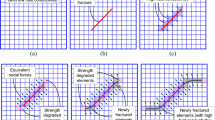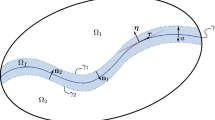Abstract
We present a fully implicit formulation of coupled flow and geomechanics for fractured three-dimensional subsurface formations. The Reservoir Characterization Model (RCM) consists of a computational grid, in which the fractures are represented explicitly. The Discrete Fracture Model (DFM) has been widely used to model the flow and transport in natural geological porous formations. Here, we extend the DFM approach to model deformation. The flow equations are discretized using a finite-volume method, and the poroelasticity equations are discretized using a Galerkin finite-element approximation. The two discretizations—flow and mechanics—share the same three-dimensional unstructured grid. The mechanical behavior of the fractures is modeled as a contact problem between two computational planes. The set of fully coupled nonlinear equations is solved implicitly. The implementation is validated for two problems with analytical solutions. The methodology is then applied to a shale-gas production scenario where a synthetic reservoir with 100 natural fractures is produced using a hydraulically fractured horizontal well.
Similar content being viewed by others

References
Annavarapu, C., Hautefeuille, M., Dolbow J: A robust nitsche’s formulation for interface problems. Comput. Methods Appl. Mech. Eng. 225–228, 44–54 (2012)
Bagheri, M., Settari, A.: Modeling of geomechanics in naturally fractured reservoirs. SPE Reserv. Eval. Eng. 11(1), 108–118 (2008)
Bandis, S., Lumsden, A., Barton, N.: Fundamentals of rock joint deformation. Int. J. Rock Mech. Min. Sci. 20(6), 249–268 (1983)
Barsoum, R. S.: On the use of isoparametric finite elements in linear fracture mechanics. Int. J. Numer. Methods Eng. 10(1), 25–37 (1976)
Barton, N., Bandis, S., Bakhtar, K.: Strength deformation and conductivity coupling of rock joints. Int. J. Rock Mech. Min. Sci. 22(3), 121–140 (1985)
Biot, M.: General theory of three-dimensional consolidation. J. Appl. Phys. 12(2), 155–164 (1941)
Borja, I.: Plasticity: modeling and computation. Springer (2013)
Budhu, M.: Earth fissure formation from the mechanics of groundwater pum**. Int. J. Geomech. 11(1), 1–11 (2010)
Chen, H., Teufel, L.: Coupling fluid-flow and geomechanics in dual-porosity modeling of naturally fractured reservoirs - model description and comparison. In: Proceedings of the SPE International Petroleum Conference and Exhibition of Mexico, pp. 483–492 (2000)
Chen, Z., Narayan, S., Yang, Z., Rahman, S.: An experimental investigation of hydraulic behaviour of fractures and joints in granitic rock. Int. J. Rock Mech. Min. Sci. 37(7), 1061–1071 (2000)
Coussy, O.: Poromechanics. Wiley (2004)
Crouch, S., Staryeld, A.: Boundary element methods in solid mechanics. Unwin Hyman, London (1990)
David, C., Wong, T.-F., Zhu, W., Zhang, J.: Laboratory measurement of compaction-induced permeability change in porous rocks: implications for the generation and maintenance of pore pressure excess in the crust. Pure Appl. Geophys. 143(1–3), 425–456 (1994)
Dolbow, J., Moes, N., Belytschko, T.: An extended finite element method for modeling crack growth with frictional contact. Comput. Methods Appl. Mech. Eng. 190(51–52), 6825–6846 (2001)
Dusseault, M.: Geomechanical challenges in petroleum reservoir exploitation. KSCE J. Civ. Eng. 15(4), 669–678 (2011)
Eikemo, B., Lie, K.-A., Eigestad, G., Dahle, H.: Discontinuous galerkin methods for advective transport in single-continuum models of fractured media. Adv. Water Resour. 32(4), 493–506 (2009)
Ferronato, M., Castelletto, N., Gambolati, G.: A fully coupled 3-d mixed finite element model of biot consolidation. J. Comput. Phys. 229(12), 4813–4830 (2010)
Fredrich, J., Arguello, J., Deitrick, G., De Rouffignac, E.: Geomechanical modeling of reservoir compaction, surface subsidence, and casing damage at the belridge diatomite field. SPE Reserv. Eval. Eng. 3(4), 348–359 (2000)
Garipov, T., Levonyan, K., Karimi-Fard, M., Tchelepi, H.: Coupled geomechanics and flow in fractured porous media. In: ECMOR 2012 - 13th European Conference on theMathematics of Oil Recovery (2012)
Garipov T. T., Voskov, D., Tchelepi, H. A.: Rigorous coupling of geomechanics and thermal-compositional flow for sagd and es-sagd operations. In: SPE Canada Heavy Oil Technical Conference (2015)
Geiger, S., Matthai, S., Niessner, J., Helmig, R.: Black-oil simulations for three-component, three-phase flow in fractured porous media. SPE J. 14(2), 338–354 (2009)
Goodman, R.E.: Methods of geological engineering in discontinuous rocks. West Group (1975)
Granet, S., Fabrie, P., Lemonnier, P., Quintard, M.: A two-phase flow simulation of a fractured reservoir using a new fissure element method. J. Pet. Sci. Eng. 32(1), 35–52 (2001)
Hansbo, A., Hansbo, P.: An unfitted finite element method, based on nitsche’s method, for elliptic interface problems. Comput. Methods Appl. Mech. Eng. 191(47–48), 5537–5552 (2002)
Henshell, R., Shaw, K.: Crack tip finite elements are unnecessary. Int. J. Numer. Methods Eng. 9(3), 495–507 (1975)
Hoteit, H., Firoozabadi, A.: Multicomponent fluid flow by discontinuous galerkin and mixed methods in unfractured and fractured media. Water Resour. Res. 41(11), 1–15 (2005)
Hoteit, H., Firoozabadi, A.: An efficient numerical model for incompressible two-phase flow in fractured media. Adv. Water Resour. 31(6), 891–905 (2008)
Huang, T., Chang, C., Chao, C.: Experimental and mathematical modeling for fracture of rock joint with regular asperities. Eng. Fract. Mech. 69(17), 1977–1996 (2002)
Hughes, T.: The finite element method: linear static and dynamic finite element analysis. Courier Dover Publications (2012)
Jha, B., Juanes, R.: Coupled multiphase flow and poromechanics: a computational model of pore pressure effects on fault slip and earthquake triggering. Water Resour. Res. 50(5), 3776–3808 (2014)
**g, L., Stephansson, O.: Fundamentals of discrete element methods for rock engineering theory and applications, vol. 85. Elsevier (2007)
Juanes, R., Samper, J., Molinero, J.: A general and efficient formulation of fractures and boundary conditions in the finite element method. Int. J. Numer. Methods Eng. 54(12), 1751–1774 (2002)
Karimi-Fard, M., Firoozabadi, A.: Numerical simulation of water injection in fractured media using the discrete-fracture model and the galerkin method. SPE Reserv. Eval. Eng. 6(2), 117–126 (2003)
Karimi-Fard, M., Durlofsky, L., Aziz, K.: An efficient discrete-fracture model applicable for general-purpose reservoir simulators. SPE J. 9(2), 227–236 (2004)
Kikuchi, N., Oden, J.: Contact problems in elasticity. SIAM (1988)
Kim, J., Tchelepi, H., Juanes, R.: Stability and convergence of sequential methods for coupled flow and geomechanics: fixed-stress and fixed-strain splits. Comput. Methods Appl. Mech. Eng. 200(13–16), 1591–1606 (2011)
Kim, J.-G., Deo, M.: Finite element, discrete-fracture model for multiphase flow in porous media. AIChE J. 46(6), 1120–1130 (2000)
Lamb, H.: Hydrodynamics. Cambridge University Press (1932)
Liu, F., Borja, R.: Stabilized low-order finite elements for frictional contact with the extended finite element method. Comput. Methods Appl. Mech. Eng. 199(37–40), 2456–2471 (2010)
Mandel, J.: Consolidation des sols. Geotechnique, 30 (1953)
Martin, V., Jaffre, J., Roberts, J.: Modeling fractures and barriers as interfaces for flow in porous media. SIAM J. Sci. Comput. 26(5), 1667–1691 (2005)
Matthai, S., Mezentsev, A., Belayneh, M.: Finite element-node-centered finite-volume two-phase-flow experiments with fractured rock represented by unstructured hybrid-element meshes. SPE Reserv. Eval. Eng. 10(6), 740–756 (2007)
Maxwell, S., Urbancic, T., Steinsberger, N., Zinno, R.: Microseismic imaging of hydraulic fracture complexity, in the barnett shale. In: Proceedings - SPE Annual Technical Conference and Exhibition, p.p 965–973 (2002)
Mikelic, A., Wheeler, M.: Convergence of iterative coupling for coupled flow and geomechanics. Comput. Geosci. 17(3), 455–461 (2013)
Moes, N., Dolbow, J., Belytschko, T.: A finite element method for crack growth without remeshing. Int. J. Numer. Methods Eng. 46(1), 131–150 (1999)
Moinfar, A., Sepehrnoori, K., Johns, R., Varavei, A.: Coupled geomechanics and flow simulation for an embedded discrete fracture model. In: Society of Petroleum Engineers - SPE Reservoir Simulation Symposium 2013, vol. 2, pp. 1238–1250 (2013)
Monteagudo, J., Firoozabadi, A.: Control-volume method for numerical simulation of two-phase immiscible flow in two- and three-dimensional discrete-fractured media. Water Resour. Res. 40(7), W074,051–W0740,520 (2004)
Monteagudo, J., Rodriguez, A., Florez, H.: Simulation of flow in discrete deformable fractured porous media. In: Society of Petroleum Engineers - SPE Reservoir Simulation Symposium 2011, vol. 1, pp. 276–291 (2011)
Nocedal, J., Wright, S.: Numerical Optimization. Springer (2002)
Nordbotten, J.: Finite volume hydromechanical simulation in porous media. Water Resour. Res. 50(5), 4379–4394 (2014)
Oden, J., Martins, J.: Models and computational methods for dynamic friction phenomena. Comput. Methods Appl. Mech. Eng. 52(1–3) (1985)
Palmer, I., Moschovidis, Z., Cameron, J.: Modeling shear failure and stimulation of the barnett shale after hydraulic fracturing. In: SPE - Hydraulic Fracturing Technology Conference 2007, vol. 2007, pp. 279–287 (2007)
Phan, A.-V., Napier, J., Gray, L., Kaplan, T.: Symmetric-galerkin bem simulation of fracture with frictional contact. Int. J. Numer. Methods Eng. 57(6), 835–851 (2003)
Puso, M., Laursen, T.: A mortar segment-to-segment frictional contact method for large deformations. Comput. Methods Appl. Mech. Eng. 193(45–47), 4891–4913 (2004)
Rutqvist, J., Stephansson, O.: The role of hydromechanical coupling in fractured rock engineering. Hydrogeol. J. 11(1), 7–40 (2003)
Rutqvist, J., Tsang, C.-F.: A study of caprock hydromechanical changes associated with co2-injection into a brine formation. Environ. Geol. 42(2–3), 296–305 (2002)
Simo, J., Laursen, T.: An augmented lagrangian treatment of contact problems involving friction. Comput. Struct. 42(1), 97–116 (1992)
Simo, J., Wriggers, P., Taylor, R.: A perturbed lagrangian formulation for the finite element solution of contact problems. Comput. Methods Appl. Mech. Eng. 50(2), 163–180 (1985)
Sneddon, I. N., Berry, D. S.: The classical theory of elasticity. encyclopedia of physics (1958)
Voskov, D., Tchelepi, H.: Comparison of nonlinear formulations for two-phase multi-component eos based simulation. J. Pet. Sci. Eng. 82–83, 101–111 (2012)
Wriggers, P.: Computational contact mechanics. Wiley (2002)
Younis, R.: Modern advances in software and solution algorithms for reservoir simulation. PhD thesis, Stanford University (2011)
Zaydullin, R., Voskov, D., Tchelepi, H.: Nonlinear formulation based on eos-free method for compositional flow simulation. In: Proceedings - SPE Annual Technical Conference and Exhibition, vol. 4, pp. 3210–3223 (2011)
Zhang, J., Kamenov, A., Zhu, D., Hill, A.: Laboratory measurement of hydraulic-fracture conductivities in the barnett shale. SPE Prod. Oper. 29(3), 216–227 (2014)
Zhou, Y., Tchelepi, H., Mallison, B.: Automatic differentiation framework for compositional simulation on unstructured grids with multi-point discretization schemes. In: Society of Petroleum Engineers - SPE Reservoir Simulation Symposium 2011, vol. 1, pp. 607–624 (2011)
Zienkiewicz, O., Taylor, R.: The finite element method for solid and structural mechanics. Elsevier (2005)
Author information
Authors and Affiliations
Corresponding author
Rights and permissions
About this article
Cite this article
Garipov, T.T., Karimi-Fard, M. & Tchelepi, H.A. Discrete fracture model for coupled flow and geomechanics. Comput Geosci 20, 149–160 (2016). https://doi.org/10.1007/s10596-015-9554-z
Received:
Accepted:
Published:
Issue Date:
DOI: https://doi.org/10.1007/s10596-015-9554-z



